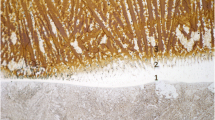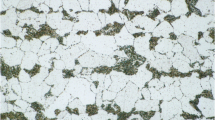Abstract
Dissimilar metal weld overlays of nickel-base alloys on low-alloy steel components are commonly used in the oil and gas, petrochemical, and power generation industries to provide corrosion and oxidation resistance in a wide range of service environments and temperatures. Traditionally, dissimilar weld overlays are produced using cold or hot wire gas tungsten arc welding. This study aims to identify and evaluate potential advantages of low heat input gas metal arc welding processes over the conventional gas tungsten arc welding in the production of such overlays. Parts I and II of this publication series described characteristics of the heat-affected zone and the transition zone region of alloy 625 on grade 22 steel overlays. These results indicate a good resistance against hydrogen-assisted cracking, which is being verified within this third part of the publication series. To determine the hydrogen-assisted cracking susceptibility, welded samples are tested using the delayed hydrogen-assisted cracking test. Fractography is performed using scanning electron microscopy along with energy dispersive spectroscopy. The results confirm the suitability and efficiency of low heat input gas metal arc welding for dissimilar weld overlays. Variation of the postweld heat treatment procedure bears potential for improvement in this respect.









Similar content being viewed by others

References
Dupont JN, Mizia RE (2010) Review of dissimilar metal welding for the NGNP helical-coil steam generator. https://doi.org/10.2172/984549
Dodge MF, Dong HB, Milititsky M, Barnett RP, Marques VF, Gittos MF (2012) Environment-induced cracking in weld joints in subsea oil and gas systems- part I. In: Proc. ASME 31st Int. Conf. Ocean. Offshore Arct. Eng. ASME, New York, pp 305–313
Savage WF (1980) Solidification, segregation, and weld imperfections. Weld World 18:89–114
Frei J, Alexandrov BT, Rethmeier M (2016) Low heat input gas metal arc welding for dissimilar metal weld overlays part I: the heat-affected zone. Weld World 60:459–473. https://doi.org/10.1007/s40194-016-0306-z
Frei J, Alexandrov BT, Rethmeier M (2018) Low heat input gas metal arc welding for dissimilar metal weld overlays part II: the transition zone. Weld World 62:317–324. https://doi.org/10.1007/s40194-017-0539-5
Beaugrand VCM, Smith LS, Gittos MF (2009) Subsea dissimilar joints: failure mechanisms and opportunities for mitigation. In: Corros. 2009 - Conf. Expo. NACE international, pp 1–12
Bourgeois D (2015) Hydrogen assisted crack in dissimilar metal welds for subsea service under cathodic protection. The Ohio State University
Dai T, Lippold JC (2018) The effect of postweld heat treatment on hydrogen-assisted cracking of 8630/alloy 625 overlay. 581–599
Beaugrand VCM, Smith LS, Gittos MF (2009) Hydrogen embrittlement of 8630M/625 subsea dissimilar joints: factors that influence the performance. In: Proc. 28th Int. Conf. Ocean. Offshore Arct. Eng. TWI Ltd., Great Abington, Cambridge, UK, pp 227–236
Rowe MD, Nelson TW, Lippold JC (1999) Hydrogen-induced cracking along the fusion boundary of dissimilar metal welds
Kou S (2003) Welding metallurgy, Second edi. John Wiley & Sons, Hoboken, New Jersey
Daniels TW (2015) Applicability of cold metal transfer for repair of dissimilar metal welds in stainless steel piping in nuclear power plants. OSU
Dai T, Lippold JC (2018) Tempering effect on the fusion boundary region of alloy 625 weld overlay on 8630 steel. 535–550
Mente T, Boellinghaus T, Schmitz-Niederau M (2012) Heat treatment effects on the reduction of hydrogen in multi-layer high-strength weld joints. Weld World 56:26–36. https://doi.org/10.1007/BF03321362
Gittos MF, Gooch TG (1992) The interface below stainless steel and nickel-alloy claddings. Weld J 12:461–472
Alexandrov BT, Lippold JC, Sowards JW, Hope AT, Saltzmann DR (2013) Fusion boundary microstructure evolution associated with embrittlement of Ni-base alloy overlays applied to carbon steel. Weld World 57:39–53. https://doi.org/10.1007/s40194-012-0007-1
Rozmus-Górnikowska M, Blicharski M (2017) TEM microstructure and chemical composition of transition zone between steel tube and an Inconel 625 weld overlay coating produced by CMT method. Arch Metall Mater 62:787–793. https://doi.org/10.1515/amm-2017-0117
Alexandrov BT, Shi S, Rodelas JM, Lippold JC (2012) A new test for evaluation of susceptibility to hydrogen assisted cracking in dissimilar metal welds. Corros 2012. https://doi.org/10.1017/CBO9781107415324.004
Sotoudeh K, Eren SE, Gittos MF, Milititsky M, Kabra S, Zhang SY (2013) Evaluation of residual stresses in steel-to-nickel dissimilar joints. Proc. ASME 2013 32nd Int. Conf. Ocean. Offshore Arct. Eng
ASTM (2014) Standard specification for forged or rolled alloy-steel pipe flanges, forged fittings , and valves and parts for high-temperature service. doi: https://doi.org/10.1520/A0182
Fenske JA, Robertson IM, Ayer R, Hukle M, Lillig D, Newbury B (2012) Microstructure and hydrogen-induced failure mechanisms in Fe and Ni alloy weldments. Metall Mater Trans A Phys Metall Mater Sci 43:3011–3022. https://doi.org/10.1007/s11661-012-1129-1
Acknowledgements
This study was supported by ExxonMobil and Fronius International through provision of materials, welding equipment, and technical support and was performed at the Welding Engineering Laboratory of the Ohio State University.
Author information
Authors and Affiliations
Corresponding author
Additional information
Publisher’s Note
Springer Nature remains neutral with regard to jurisdictional claims in published maps and institutional affiliations.
Recommended for publication by Commission IX - Behaviour of Metals Subjected to Welding
Rights and permissions
About this article
Cite this article
Frei, J., Alexandrov, B.T. & Rethmeier, M. Low heat input gas metal arc welding for dissimilar metal weld overlays part III: hydrogen-assisted cracking susceptibility. Weld World 63, 591–598 (2019). https://doi.org/10.1007/s40194-018-0674-7
Received:
Accepted:
Published:
Issue Date:
DOI: https://doi.org/10.1007/s40194-018-0674-7



